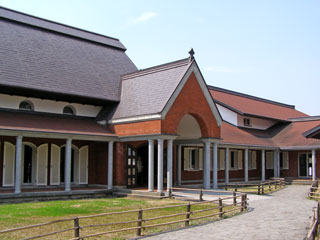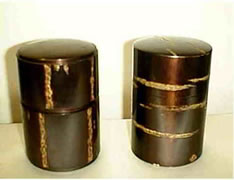The Kabazaiku Woodcraft Museum 

The Kabazaiku Woodcraft Museum opened its doors shortly after kabazaiku, or “cherry bark work,” was designated a Traditional Craft of Japan in 1978. Its construction was overseen by Ōe Hiroshi (1913–1989), an architect known for blending Western Modernist elements with traditional Japanese architecture in his designs.
Cherry bark work was introduced to Kakunodate in the 1780s by the samurai retainer Fujimura Hikoroku (dates unknown). It began as a folkcraft predominantly made by lower-class samurai to earn extra income but developed into a stable industry with professional artisans and wholesalers in the early twentieth century.
The Demonstration Room on the first floor gives visitors the chance to observe a craftsperson at work and ask questions about the items the artist is making. Tea caddies, tobacco holders, and seal cases (inrō) made by leading kabazaiku craftspeople of the past 230 years are on display next door in Exhibition Room #1. The oldest piece in the collection is a seal case that is believed to be the work of Fujimura Hikoroku himself.
On the second floor, Exhibition Room #2 displays a rotating selection of traditional objects and artwork throughout the year. The permanent display in Exhibition Room #3 showcases past possessions of the Satake-Kita samurai family, such as sword hilts, armor, and paintings.
Next to the gift shop on the first floor, Exhibition Room #4 features important objects related to Kakunodate, including its festivals and other traditional handicrafts, such as straw work, Shiraiwa-ware pottery, Itaya basket weaving, and Shunkei lacquerware.
*Please note that displays are subject to change.
- Location
- 10-1 Omote-machi Shimo-cho, Kakunodate-machi, Semboku-shi, Akita 014-0331
- Contact Info
- Semboku City Kakunodate Kaba Craft Densho-kan
Tel: 0187-54-1700 Fax: 0187-54-1701 - Traffic access
- 20 minute walk from JR Kakunodate Station
Cherry Bark Work

Kabazaiku, or “cherry bark work,” has been practiced in Kakunodate since the 1780s. Artisans who work with cherry bark strive to bring out its natural luster, grain, and striking red undertones to create elegant items that are as beautiful as they are practical. Cherry bark’s outer layer is porous, facilitating air flow, and oils in the inner layers stabilize the moisture of the wood, keeping it from becoming too dry or overly saturated. This helps keep the contents of containers made with cherry bark fresh.
There are three main types of kabazaiku: katamono (rounded), kijimono (flat), and tatamimono (layered).
Katamono is the most representative form of kabazaiku and is typically used to make tea caddies, tobacco holders, and seal cases (inrō). The bark of the Yamazakura cherry is harvested and left to rest for three years before the outer layer is shaved off to reveal the natural grain underneath. The bark is then covered with glue and attached to a wooden base piece using a heated iron trowel. This core is either tubular or circular in shape and is fashioned to match the natural shape of the wood.
Kijimono refers to cherry bark work that is applied to flat surfaces, like boxes and trays. The method was developed by artisans in the Meiji era (1868–1912) and has since been used to decorate everything from tearooms to grand pianos. A tearoom covered in kabazaiku can be found in the Kabazaiku Woodcraft Museum and a kabazaiku-faced grand piano is on display at the Hirafuku Memorial Art Museum.
Tatamimono is the only method in which artisans layer the cherry bark upon itself and carve it into different shapes. Traditionally, this was used to carve miniature sculptures (netsuke) that secured tobacco holders and seal cases to kimono sashes, as well as the drawstring-fasteners that held these cases shut. More recently, tatamimono has been used to make brooches, pendants, and other accessories.
- Access
- Sightseeing Spots
- Choose from areas
- Hachimantai/Tamagawa
- Nyutou
- Tazawako Plateau/Mizusawa/Komagatake
- Tazawako
- Dakigaeri/Jindai/Shiraiwa
- Nishiki
- Kakunodate
- Seasonal Recomendations
- Lists by Season
- Campgrounds
- Products
- Other
